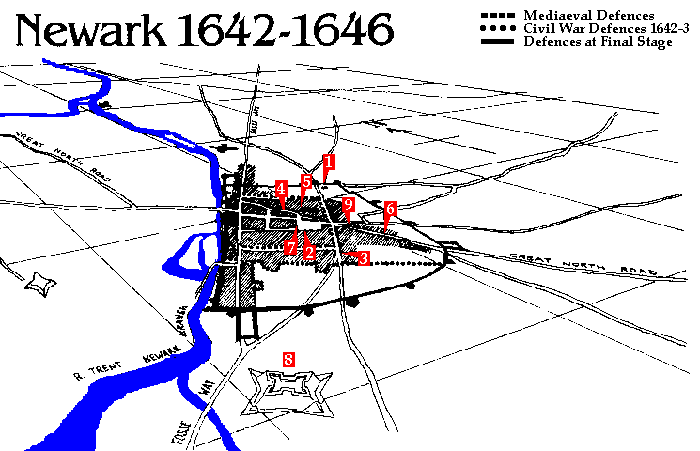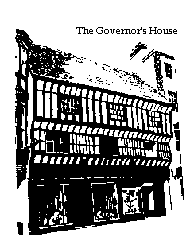
This is my home town, or to be more precise, where it is on the map.
Press HERE for the history of Newark in The Civil War
Newark-on-Trent, despite the derivation of its name (new work) has
been around for some time. Recent excavations at the castle
established that here was a settlement here in Anglo Saxon times.
The Castle at Newark predates Bishop Alexander of Lincoln who
substantially extended the living quarters in the twelfth century.
A settlement grew up where the Great North Road crossed the River
Trent. The Fosse Way, a roman road running between
Lincoln(Lindum) and Bath(Aqua Sulis) runs along the east bank of the
river at this point. Its strategic importance is marked by the fact it had
a castle, and up to the Civil War, a full town wall. In the Civil War
itself it was a garrison town for the Royalist forces and successful
survived three sieges.
The modern town is small, and has a population of about 28,000. Its
principal industry is light engineering, and many people in the town
commute to work in either Nottingham or Lincoln. Newark also has
the highest incidence of bicycle ownership in the country.
So that's it. As a tourist guide it could have been a little longer, but
there really is very little more that can be said of Newark itself. It is a
small cosy little English market town which has been blessed by the
fact that it isn't sufficiently remarkable to attract international attention
as a tourist attraction. I'll settle for that. I moved to Newark from
Birmingham in the West Midlands in about 1985 purely through
choice. I had had enough of life in a major conurbation. I wanted to
live somewhere where you had the space and time to do things which
give quality to your life, and a town like Newark allows you to do that.
So here's some of the thoughts I have about life in Newark.
Whenever I have to go to either Nottingham or Lincoln on business I
go along the A46. It's a single carriageway which carries far more
traffic than it was ever designed for. People are forever campaigning
about turning it into a dual carriageway. I'm relieved that with a
change in transport policy that's now unlikely to happen, and much of
the countryside around these parts will be spared.
The original road was not designed for juggernauts, but chariots. The A46
follows the line of the Fosse Way built by the Romans, and is still called The Fosse by the
locals. On a drive back you can meditate on the countless thousands
who have followed this route over the last 1900 or so years. As you
come over the brow of the hill at Stoke you can see over the Trent
Plain the spire of St Mary Magdalene a landmark for travellers for only
the last 500 years.
You pay your money and you take your choice. You can have a view
of history which pigeon holes it into an interesting though mostly
insignificant subject which doesn't have a great deal of bearing on
your life. Alternatively you can see history as something which
happens now...
The truth of the matter is that for much of the time people got on with
their business without much notion that its consequences would be
assigned historical significance.
So as you wander round Newark you may speculate that King John
did not intend to die at the Castle from 'a surfeit of Lampreys'. Some
have suggested that he was poisoned. He wasn't a popular king, and
history has not been kind to him. The truth of the matter was that he
was a more diligent and attentive monarch than his brother King
Richard I who spent most of his reign abroad. It is unlikely that king
or assassin spent too much time pondering about how posterity might
view their actions. They just got on with it.
Newark has given its name to fifty plus towns and cities around the
world. They vary in size from Newark, New Jersey with a population
of about half a million people to Newark, Northern Territory, Australia
which is a sheep station. At a meeting of the Newarks of the World in
1995 at Newark, it seemed that all the delegates had a keener
interest in the history of the Mother of all Newarks than the residents
had themselves.
Which is why I like the place. There is a lack of self consciousness
about the people of this town about its heritage which in a perverse
way has helped to maintain it. It hasn't been prettified. Its kept its
essential character. It has not been turned into a tourists theme park.
Despite the changes of the last century the spire of St Mary
Magdalene, and the bulk of the Castle are still the dominating
features of the Town, and from day to day, month to month, year to
year, century to century, people have got on with the business of
living here. I like it! |
Home

 As did King Charles I. At the Governors House on the corner of the
Market Prince Rupert attempted to confront his uncle with the reality
that the Royalist cause was lost. Charles in turn accused the prince of
cowardice and banished him. At the upper window of the Saracen's
Head a few doors down a young William Gladstone may have aspired
to a place in history when he made his first election address as a
politician. It is more likely that his mind was more intent on winning
the seat. At a house on the opposite corner of the Market Square
Lord Byron had his first scribblings as a poet printed and published.
Governor'sHouse, Saracens Head, Publishers now function as cake
shop come restaurant, bank and grocers shop respectively in a town
which goes about its business as a living entity rather than existing as
exhibits in a museum.
As did King Charles I. At the Governors House on the corner of the
Market Prince Rupert attempted to confront his uncle with the reality
that the Royalist cause was lost. Charles in turn accused the prince of
cowardice and banished him. At the upper window of the Saracen's
Head a few doors down a young William Gladstone may have aspired
to a place in history when he made his first election address as a
politician. It is more likely that his mind was more intent on winning
the seat. At a house on the opposite corner of the Market Square
Lord Byron had his first scribblings as a poet printed and published.
Governor'sHouse, Saracens Head, Publishers now function as cake
shop come restaurant, bank and grocers shop respectively in a town
which goes about its business as a living entity rather than existing as
exhibits in a museum.